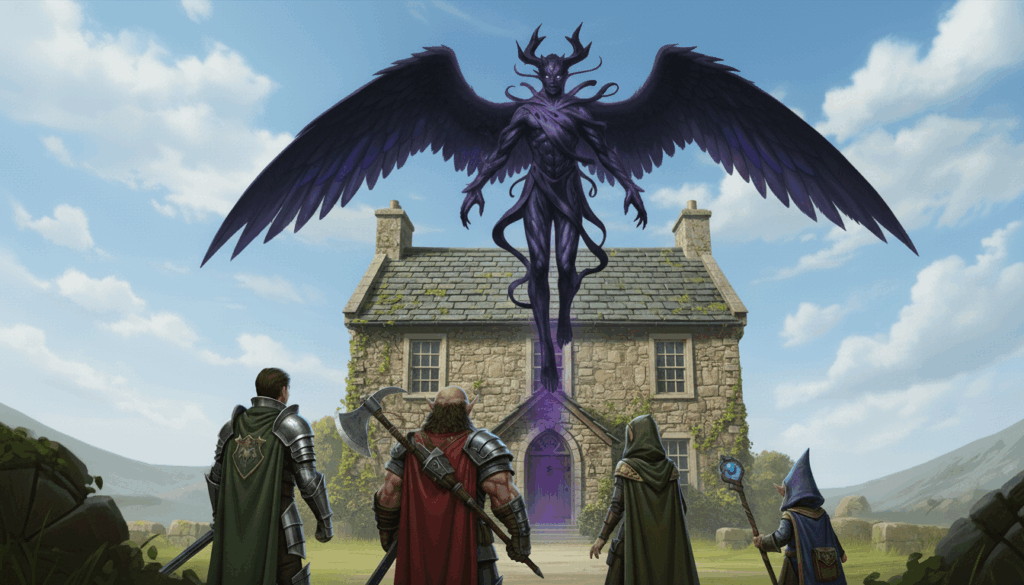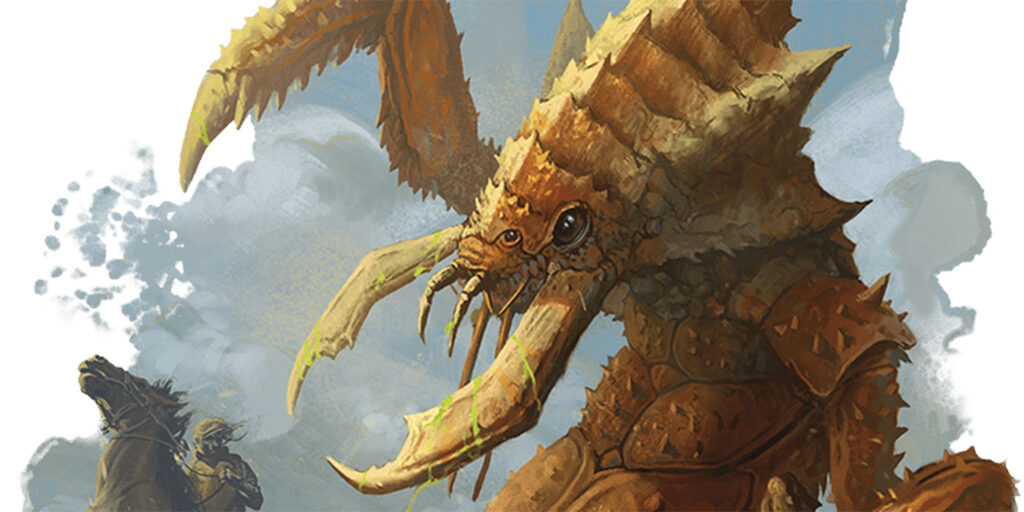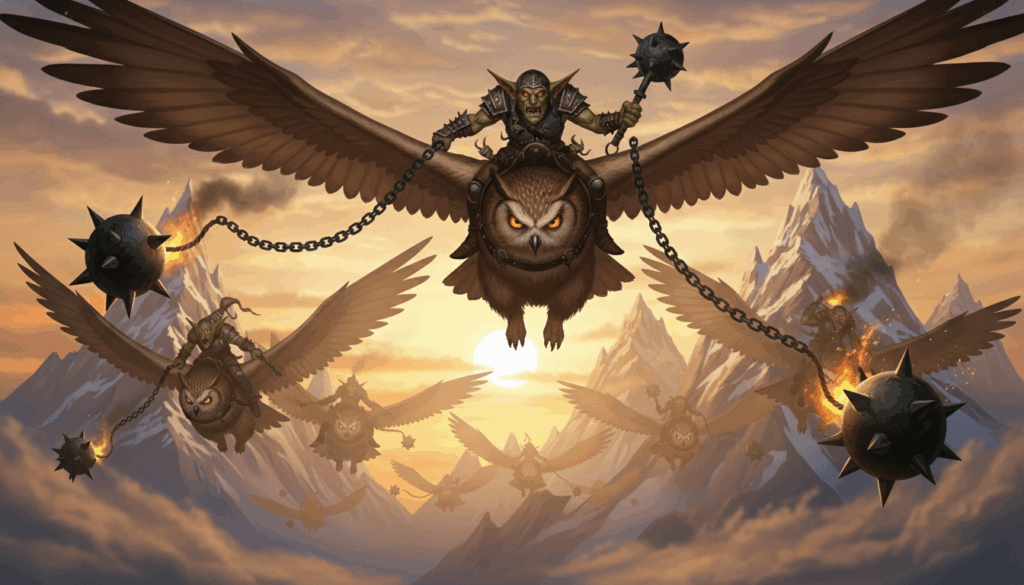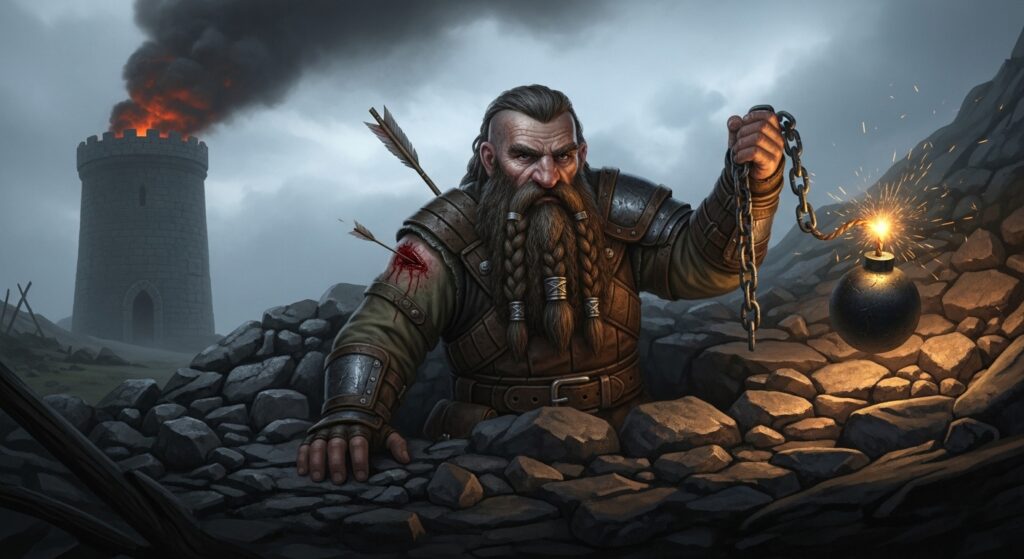RECAP: Triumphant Return of BDC, 10-10-25
The air was crisp and clear when the party emerged from the pile of detritus that was the ancient death church. Jarlebank’s eyes blinked and watered a bit in the sunlight, after the oppressive dark of… well, let’s be honest, the Hells. The words of the pit fiend still echoed in their ears: you are not ready. Go back, and a guide will come for you. Return when you are ready, but not a moment before.
And so they left. Back into the light, back into the diffident, insect-like industry of the hobgoblin camp. The hobs yet avoided the church, and so the group was surprised to see one of them, clad in rune-festooned leather rather than the chain hauberks that most of the creatures wore, tread gingerly across the broken stones and charred beams that littered the landscape between the party and the invisible but tangible barrier that kept the rest of them at bay.
“None have emerged before you,” said the approaching shaman, rather obsequiously. “None have emerged with the sort of…”
The shaman paused, grimacing.
“… the sort of vetting that accompanied this emergence.” The shaman’s eyes flickered over to the ruined doorway from which the party had recently come. They had a uncharacteristically wild look in them, wide and staring. “I have been informed that you await a visitor. Under my orders, you are to be given succor and every courtesy until that visitor arrives.”
The party was immediately escorted off the church site and to a large stone house, spartan but cleanly appointed. It struck them again that these hobgoblins were, despite their ancestry, were very different from their lesser kinsman. And there, they settled in to wait, for the cryptic “agent” of which the pit fiend had spoken.

They did not have to wait long.

A creature, tall and black, appeared a few dozen feet the door to the party’s camp. “Come forth,” it said. It’s voice was quiet as a breeze, yet no on there failed to hear it. It was as if the voice reverberated through a series of dimensions, each culminating at some focus point inside each of their ears.
“Come. Forth.”
They looked at each other and, raised eyebrows all around. Outside the creature floated a few feet off the ground. Every hobgoblin had vanished.
“What is that?” Peach asked Jarlebank, sotto voce.
“That, my dear,” Jarlebank whispered back. “… is a vaati.” He paused. “And unless I miss my guess, that one is a haikjadeam vaati, which translates very roughly into ‘teacher’ or ‘police’.”
Peach’s eyebrows rose a few milllimeters. “Teacher or police? Those two seem very different.”
“To us, perhaps. Certainly to you. To them? Not as much.”
The creature gazed at them in a strange, surreal silence, and Jarlebank made his way forward.
Jarlebank bowed low before the visitor, and spoke in a language that had a strange resonant, tonal, and airy quality, in which the words that rose and fell like gusts, with elongated vowels and soft fricatives.
“Shael’thera, Vath’raad Elai. Esha taraan’thir seluun, elen va’thra shan. Kureth ilas, na shaevan?”
(“Greetings, Lord of the Vaati. We are blessed by your presence. How may we serve you?”)
The Vaati looked down at Jarlebank and spoke again:
“Vaan’el shael, Kuraeth Vath. Nae’ruun Dael’Ar, ilas’ther va’kurei.
Oshaeth lirraan duun Ael’tha, ensha va’raan ul shaen’raad.”
(“By the edict of the Wind Dukes, I am sent. To you is given the task:
persuade the Guardian that your breath still carries the worth of the Rod Unmade.”)
“Shael’an varuun, Elai,” said Jarlebank. “Tesh’laan va’rin aes, na duun vel?”
(“Glad tidings indeed, Lord of Vaati. Whither shall we accompany you?”)
“Vael’tha runaan ilas’ther ael’duun. Vaaris shaen: thuur’aan nor’el, silas va’renn. Veth’raan va’dor, nae’shel un va’raan. Kuur’ath talan nor’esh — thuur’aen hael, shaevan va’theren.”
(“I have spoken with my kindred, and the wind carries our will: go northward, beyond the eye of hatred. We shall follow your wake, but lightly, lest our gaze betray its mark. Gird your warmth—the mountains breathe cold, and your flesh forgets such air.”)
The Wind Duke continued:
“Shae’vaar ilen duun va’raan, ael’theren, na duun va’tal enshael;
en thuur’aen shael’kar vel thun’raan chae’os.”
(“I can take you some of the way, but not the entire way,
for to do so would draw the attention of chaos.”)
Then:
“Vael’aen lirraan ul shaev’ath. Eshaen va’kurei shael’laen nor’ath. Va’rin thuur’aen elen’kaar.”
(“Here are some gifts to aid you after I have departed. Use them in your need.”)
Jarlebank nodded.
“Vaen, Elai’sha. Ilas’ther vael’tha elen’kaar — shaev’an ul nor’ath, ensha va’raan lirraan.”
(“Of course, your excellency. Your gifts are precious to us, and we shall use them with gladness.”)
At that, a series of bandoliers of strange manufacture, of a light, almost spider-silk like weave, materialized on the ground at the party’s feet. There was one for each of them, and they were laden with a selection of small crystalline bottles, with waxed caps:
- Three potions of Cure Moderate Wounds
- Two potions of Cure Serious Wounds
- One potions of Gaseous Form
- One potions of Fire Resistance (20)
There was also, with the bandoleers, a selection of winter clothing – gloves, hats, robes of ermine and wolf-fur – from which the individual members of the party selected items suitable to themselves.

In minutes the party was ready and the Wind Duke bore them upward into the sky. The speed was breathtaking as they moved north, and every one of them, at some point, suffered from a strange an unnerving bout of vertigo that combined both height and speed. The ground sped beneath them, and they travelled in this manner for several hours. Mountains materialized in the distance, as did a large lake and nearby town – over which they flew at speed. A few minute later, then landed on the northern side of the lake, and the Wind Duke bade them farewell. The creature gestured for the Rod, which Jarlebank handed over willingly. It gestured over the artifact a few times, then said:
“Shaél thurae na’veth aruun, veith-kan dra siraen ten-tor, dho marun var thae nira-haen.”
(“Veil holds the breath of power for ten-turns-and-four, fading with each call of its name.”)
Jarlebank turned to the rest, who were still catching their breath and stretching their limbs after hours of high speed travel. “This Wind Duke says he has placed a mask over the emanations of the Rod. It will last a fortnight, unless we overuse it.”
With that, the vaati raised a hand in salute: “Avael tharûn, keth-shaé alun.” (“Fortune’s wind upon you, brave ones.”). And with that, it departed, wisping away like smoke in a breeze.


Taking stock of their surroundings and attempting to remember various landmarks they’d passed over during their voyage with the vaati, the group tried to sort out where exactly they were. Jarlebank has some small travel atlases and a working knowledge of geography, and (although he openly admitted he could be quite wrong) he surmised they were perhaps two to three times farther north than where they’d previously been east of the Sea of Dust – probably in the southern portion of the Crystalmist Mountains, east of the Dry Steppes:

They began travelling north, following the vaati instructions. It was difficult going – although the lake valley they were in was certainly more temperate than the heights, the ground was hill and tiring, slowing their speed significantly. A half-day’s travel brought them to a ridge, upon which they found a grisly sight: three dwarves, stripped of equipment and staked bodily to the ground, with fearful countenances on their faces and (after a moment of quick deliberation on the par of Shepherd) drained of their blood. So completely so, that no blood remained in their bodies, nor was any on the ground underneath them.
Simon examined the surrounding ground for tracks, and found many: several large creatures with paws, like wolves or worgs, but further: many tracks, easily identifiable as goblins. Worgs then. But dwarves were typically more than a match for goblins, even worg-riders, and never in Simon’s experience (and Sonia’s as well) did goblins who’d bested a dwarvish patrol ever stake their victims and drain their blood.
As curious as they were, they didn’t have time to discuss it, for over the ridge emerged an enormous thing from the ground, An ankheg, a creature from the depths that hunted by vibration and fed on nearly anything.

Simon and Aladar are caught by the creature on the far side of the ridge, and are soon engaged, while the rest of team moved swiftly to aid them. Shepherd used Dimension Door to cover the ground more swiftly, but it allowed the ankheg to spit acid on the majority of the party, which did not tickle. Peach eventually finished the thing with an series of well-placed arrows.
Afterward, the party tried to determine if it was the ankheg that might have drained the blood from the doors, but that theory was soon discarded. Ankhegs love to kill and eat whatever they can catch, but the finder points of bloodletting are beyond them. They were also able to complete their earlier discussion regarding the dwarves, coming to no conclusions but averring:
- The dwarves were drained while alive, but no puncture wounds were visible. Undead are fond of blood, but the obvious candidates leave marks.
- The candidates that wouldn’t leave marks would kill by enervation, but creatures killed in that manner retain their blood. In all, undead seemed a less viable theory with each passing moment.
Sonia searched the bodies of the dwarves for anything that might give clues as to from where they’d come, while Simon redoubled his efforts to find explanatory tracks. The goblins had not, it turned out, stripped the dwarvish bodies: they still retained their armor, which to Sonia’s experienced eye was of high quality but completely devoid of identifying marks. They removed the armor and put it their portable hole, perhaps to show it to any dwarves in the region and gain more information.
Simon had not found anything more illuminating on the ground, so the party decided to follow the tracks of the worgs. A child could follow these, so it seemed likely the worg-riders expected no pursuit. over the next few hours, it became clear that several groups had peeled off the main group, although leaving a core group that the party continued to follow. In order to follow at speed, Sonia joined Aladar atop Thrax, and the rest of the party rode on the carpet.

The scenery and speed (and lack of obvious foes) and almost lulled them into a sense of security when the attack came. Goblins on flying owlbears swung in at them out of the sun, whirling iron chains with bombs attached to them like large exploding bolos. One struck the carpet and scorched it, sending it to the ground as a platoon of worg-riders emerged from some nearby woods. This was a coordinated attack, from both air and ground, and augmented (and they quickly found out) by stands of archers raining arrows upon them. The attack seemed to come from all directions at once.

While the owlbears swung around for another pass, the party made good their own response.
- Jarlebank blasted ice and steam at the coming attackers, successfully disrupting attacks and killed several goblins.
- Peach scored several arrow hits, including shooting a goblin off an approaching owlbear and then shooting the confused owlbear.
- Aladar and Thrax intercept the second owlbear attack, driving them off. It’s clear they were not expecting much resistance – certainly not magic, even more so a counter-aerial attack.
Most of the goblin forces began to retreat at this point, their initial shock attack having gone significantly awry. Sonia, enraged, gave chase to one dismounted owlbear rider, who whirled and faced him with an envenomed blade. Sonia killed the creature, but not before it was able to give him a slash and poison him, albeit not badly. A quick review of the bodies turned up no coins, but al the goblin equipment – armor, weapons – was of dwarven make. It had been modified to fit goblins, and the modifications were of much poorer quality, but the original pieces were unmistakably dwarvish.
Once they’d recovered themselves, Simon spotted a column of smoke in the distance. Focused on the tracks and maintaining capture speed, they’d missed the smoke in the distance. But now they approached at full speed, racing the sunset (which was only about two hours away) and assuming (wrongly, as it turned out) that this place was from where the goblins had come.
The charnel house smell of fresh corpses emitted gassily from a tunnel entrance, guarded by a small tower. The smoke they’d observed had come from the tower, and the surrounding area was littered with the dead – mostly dwarves, some goblins.
Simon quickly examined the bodies and estimated that the fight had taken place two days before. Some 30 dwarvish bodies were found, meaning this was an established mining camp. The numbers suggested that it would take more than the average goblin tribe to do this much damage, but considering the attack they’d just fended off, these goblins certainly weren’t average in any sense.

Sonia had just begun to head for the mine entrance, hoping to discover survivors, when one materialized from under some rubble, waving a bomb on a chain and screaming threats. Sonia quickly approached and calmed him down, telling the surviving dwarf that we’re here to help.
He put down the bomb and told his story:
“Cheers, pal — ah owe ye wan. Ma whole bloody family got skelped here, two days back, when thae wee goblin bastards came roarin’ in oan their big daft wolf-things. Took everythin’ worth nickin’, cut doon anywan that blinked at them. Ah wis oot workin’ the fields, came runnin’ when ah heard the screamin’, an’ caught an arrow in ma shoulder fur ma troubles. Bled like a burst bag an’ hit the deck — gobs must’ve figured ah wis deid.”
“Heard them bletherin’ aboot some army on the march — sounded like the start o’ somethin’ big, ken? Beyond that, nae clue whaur they’re crawlin’ out fae. Ye no fae Oredeep, then? Naw? Torag’s balls, man, whit’re ye daein’ way oot here in the arse-end o’ nowhere?”
Further questioning only found that they goblins had come from somewhere to the north – “the only way they could’ve snuck up oan us like that, right?” the dwarf admitted. “Never seen the wee sods this well put-thegither afore, like a proper army. An’ there’s nae bloody way they’ve got real dwarven mail — we’re the only folk this far north wi’ the know-how tae forge it!”
After the sun went down, they took this dwarf near the gates of Oredeep (the town across the lake, that they’d seen on their approach), and let him enter the town and safety. The party hung back, not wanting to be seen and certainly not wanting to be seen flying a carpet. They returned to the dwarvish mine, and camped for the evening in the still-soldering tower.





